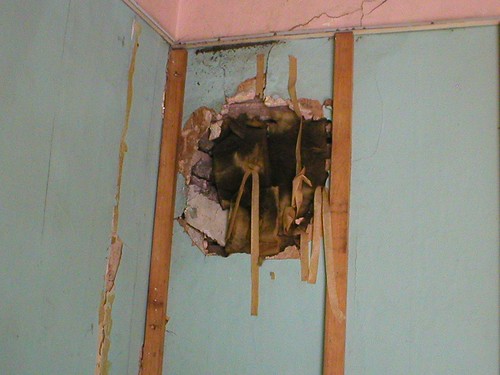
In another corner of the room, you can see the sorry state of the plaster -- not drywall or sheet rock, but actual plaster -- walls.
 It's like this all over the room. The plaster crumbles away at a touch. We're going to have to tear it all down -- a very messy prospect -- and put up new drywall. Not that we didn't expect to have to do this -- we knew we were probably going to have to re-drywall every room in the house. It's just that the reality is a little daunting.
It's like this all over the room. The plaster crumbles away at a touch. We're going to have to tear it all down -- a very messy prospect -- and put up new drywall. Not that we didn't expect to have to do this -- we knew we were probably going to have to re-drywall every room in the house. It's just that the reality is a little daunting.Good thing the only thing we ever get for Christmas and birthdays anymore is Home Depot gift cards!

3 comments:
You don't have to rip out all the plaster. You may want to rip out walls that need insulation or electric or plumbing lines installed. You can buy thin drywall boards that you can put directly over the existing plaster walls. You could also fix the plaster with some metal lath, a bag of hydrated lime, some plaster of paris, a few bags of sand and a bucket of joint compound. The cost to repair will actually be less in materials (about $30 or so), take less time and be equally as frustrating.
Because of the extent of the renovation, almost every wall needs something done to it -- electric, plumbing, insulation, cable, whatever -- so we had planned on drywalling anyway. We're not all that interested in repairing the plaster; more surprised that it is there. We had no idea what we would find behind the panelling.
The other issue is that several walls are being torn down to open up the floor plan. The new walls will have to be drywalled anyway.
Wait. That looks like my house. Only the paint is different, and the hole a different shape (our hole is on the ceiling).
And, yes, I've torn out lots of paneling coverups, and done GOBS of patching. I managed to get our diningroom walls back to a structurally sound state with only one bag of patching plaster.
Check out my blog for pics of the saggy ceiling. We're going with plaster bolts for anything loose but still mostly keyed, combined with patched-in drywall for the big ceiling holes.
Post a Comment